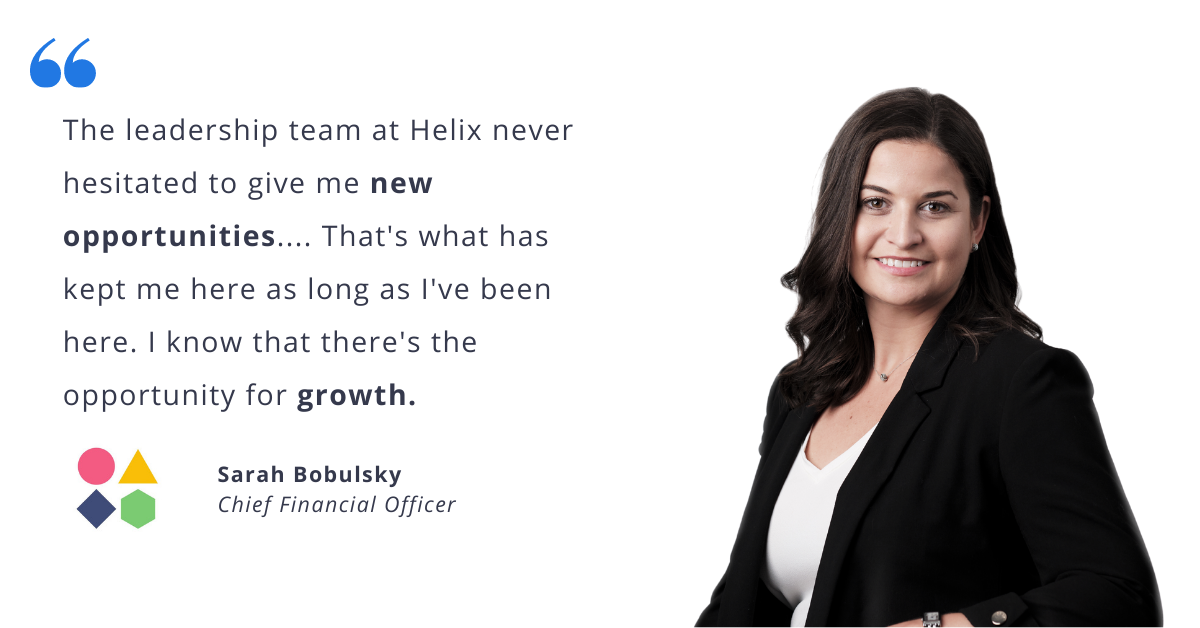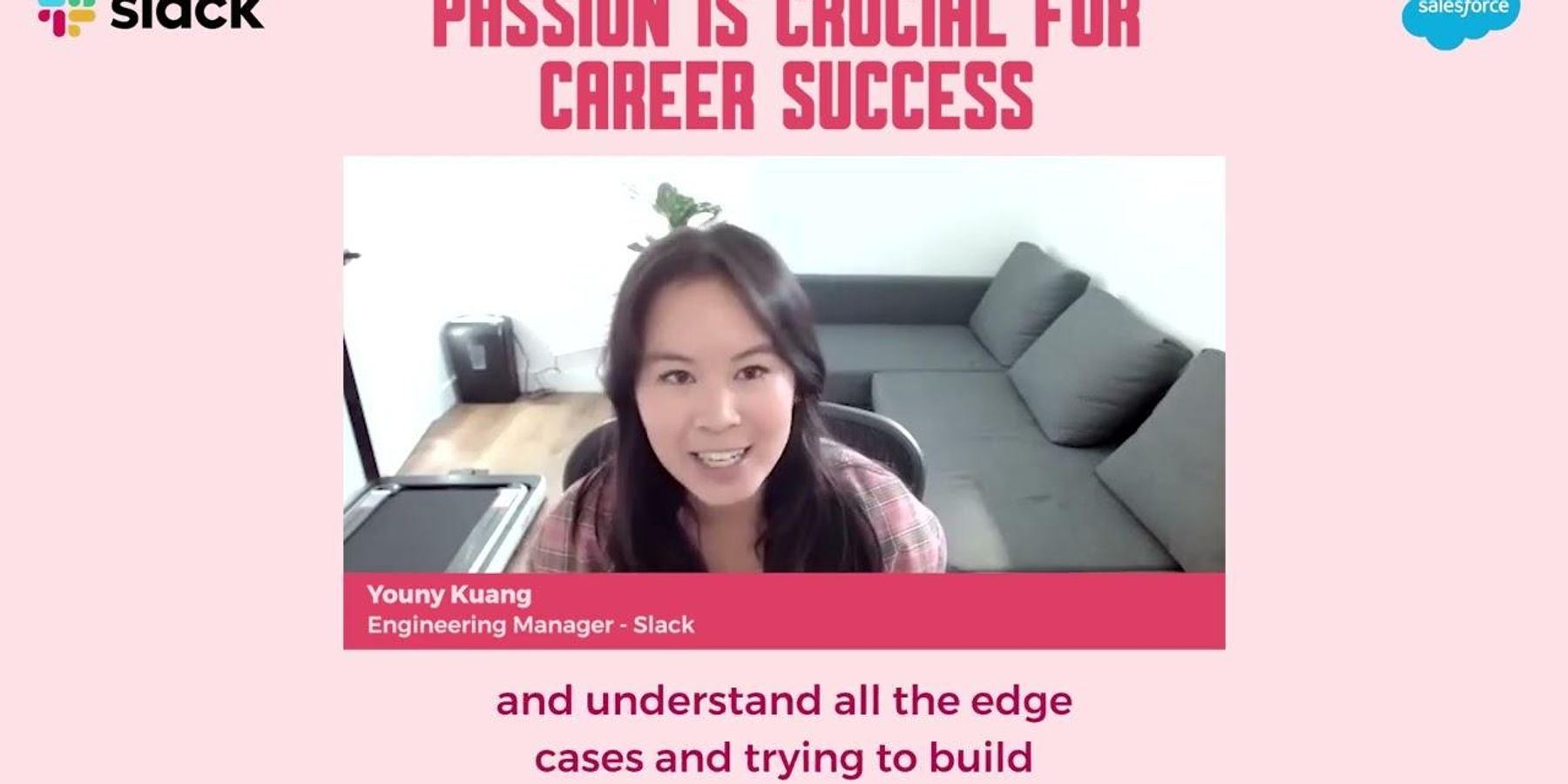Before starting her journey at population genomics company Helix, Sarah Bobulsky worked in strategy consulting, most often with pharma and biotechnology clients. She accumulated a wealth of experience very quickly: “One of my managers always said ‘one year in consulting is like seven years in a regular job’,” Sarah jokes.
In spite of her rapid exposure to so many different projects and clients, she was a bit hesitant when her firm wanted her to branch out into diagnostics. “My reaction was, ‘I don't know anything about diagnostics! I don’t want to do diagnostics,’” she laughs. “Yet, here I am CFO of a diagnostics company.”
“I would not have guessed that I would be a CFO,” she confesses. “I always hoped my career would advance, but I don't think CFO was where I was starting my thinking.”
But thanks to a lot of hard work and encouragement from current and former managers, Sarah took on the CFO challenge and is thriving in her new role.
Now that she’s settled in, Sarah’s looking to expand the finance team at Helix. We sat down with her to learn what interested candidates can do to stand out in the application process.
The Road to Helix
Sarah ultimately said yes to the project with the diagnostics company and that led to three years of consulting frequently with diagnostics clients. “I ended up being pretty well-versed in that space,” Sarah says, explaining how she heard about Helix when they got their first round of funding. The company immediately caught her attention.
“I thought their business model at the time was really interesting. It was a departure from what other companies in the space were doing, with a lot of opportunity for innovation,” she says.
Sarah also happened to know one of the cofounders of the company through her previous consulting experience. This led to some organic conversations about opportunities at the company.
“I was interested in joining a startup, but also somewhat risk-averse,” says Sarah. “So finding a startup that had strong backing was appealing to me.”
She was also reluctant to lose the diversity of experience afforded to her by consulting, but she felt that Helix was dynamic enough to ensure that she’d still get to tackle lots of different kinds of challenges. So she took a leap and accepted a role focused on corporate development and strategy.
“I accepted the position without a job description,” Sarah reminisces. “When I first started, I worked on a lot of different projects, many of which were very much outside of my comfort zone,” Sarah says. “Over time, the number of projects kept expanding, and as the company grew, the role expanded and got more operationally focused.”
Working instrategy involved a lot of long-term planning and scenario analysis. But as Sarah’s role became more operational, she found value in better understanding the day-to-day operations on the ground. “I think getting my hands dirty was really important [in understanding] how little things can influence the company's strategy,” Sarah explains. She worked closely with Helix’s customers as well as with numerous cross-functional teams which helped her better understand the ins and outs of Helix’s product. This proved to be a great foundation as she moved into the CFO role.
Journey to the C-suite
Although she didn’t originally set out to be a CFO, Sarah spent much of her career working closely with her finance counterparts — both in her consulting days pre-Helix and during her time at Helix. It was Helix’s former CEO, himself a prior CFO, who initially raised the idea of moving fully into finance though. “He was the first person to tell me I’d make a good CFO and honestly I was very surprised at first,” Sarah explains. She was initially concerned that she didn’t come from a traditional finance background. “But he was thinking more about the strategic side of the CFO role, from being able to tell the story of the business to investors and to our board, and being able to understand different nuances that drive a forecast and long-term value.”
Helix’s former CEO wasn’t the only person supporting Sarah through the transition. “Our current CEO and co-founder has never hesitated to give me new opportunities. It’s always a bit of a risk to give someone something they’d never done, but I’ve always found leadership at Helix willing to take that risk” Sarah explains. “That's been a hallmark of my time here and what has kept me here as long as I've been here. I know that there's the opportunity for growth.”
Nearly 7 months in the CFO role, Sarah has spent a significant amount of her time focusing on a long-term value perspective. “We spend a lot of time on our annual budget, our forecasts,” she explains. “I spent a lot of time in the first couple of months painting a picture of 2024 and 2025 — What does that look like? How do we get there? What are the things that drive value?” She’s now looking for mission-driven finance professionals to bring their diverse perspectives and experiences to her team.
3 Essential Attributes in Finance & 3 Tips for Interviewees
While role-specific experience is important, there are three main attributes that Sarah looks for in any potential members of the finance team at Helix, regardless of position.
- Intellectual curiosity. “Even if you're not necessarily involved in the day-to-day on-the-ground operations, it's still really important that you understand how our business works. It influences everything we do on the finance team from invoicing customers to recognizing revenue to long-term forecasting,” Sarah explains.
- Creative problem solving ability. Problem-solving isn’t always about the solution itself, but more about how you created the solution. “I always look for examples of how someone solved the problem creatively or did a lot with only a little,” Sarah shares.
- Detail-oriented. “I'm a fairly detail-oriented person, and I think that's important in lots of roles, but I think it's particularly important in finance,” Sarah reiterates.
If that sounds like you, you might be a good tip for Sarah’s team! Keep reading for Sarah’s advice on how to display the attributes above during your interview (if you want to learn more about the interview process at Helix, click here!).
- Highlight Your Impact. “When you’re giving an example or answering a ‘tell me about a time’ question, make sure to highlight how what you did had an impact on the company – whether it’s optimizing a process or uncovering a new trend in the data – make sure that stands out,” Sarah says.
- Frame the narrative upfront. When explaining previous work, Sarah suggests using roadmapping language for your interviewer such as, “This was a big project. Here are the three things I'm going to tell you about it. And then walk [the interviewer] through each of those three things.”
- Be selective. While providing depth in your responses is important, be judicious about what you share. “Interviews are usually only 30 or 45 minutes, so it's not about describing every little detail. Acknowledge all of the things you had to consider, and then choose a few critical things to highlight,” she explains.
Interested in working alongside Sarah at Helix? Check out their open positions here.




